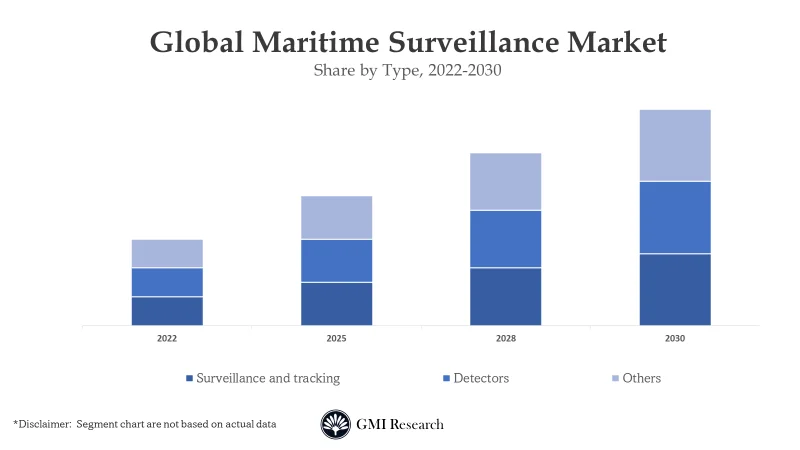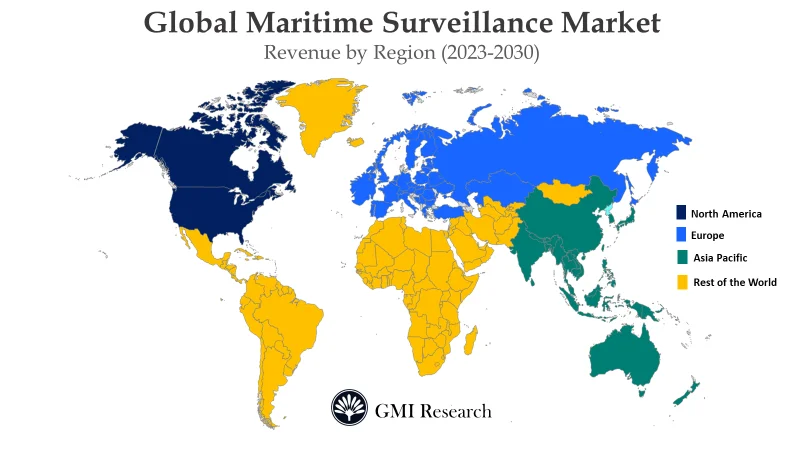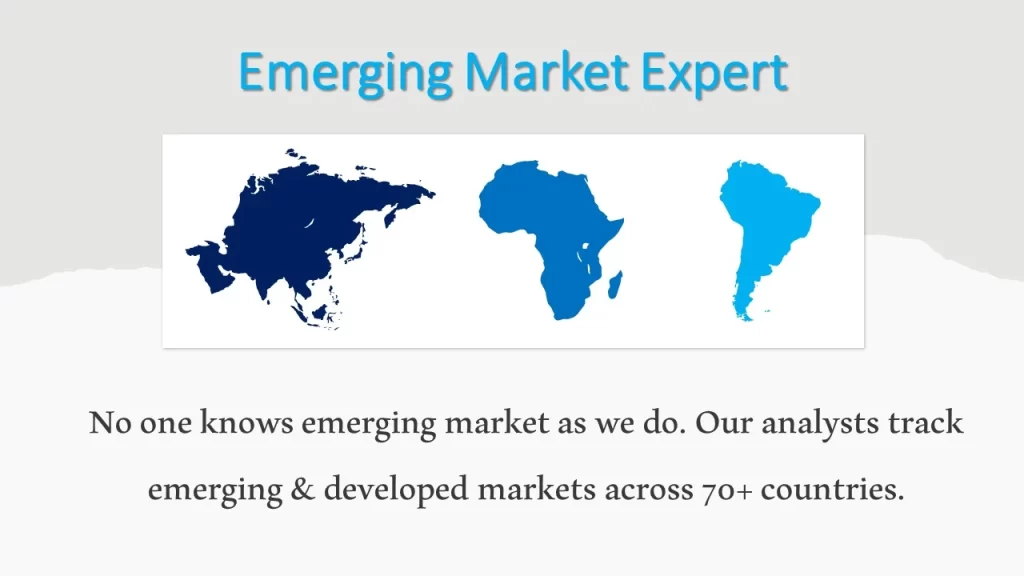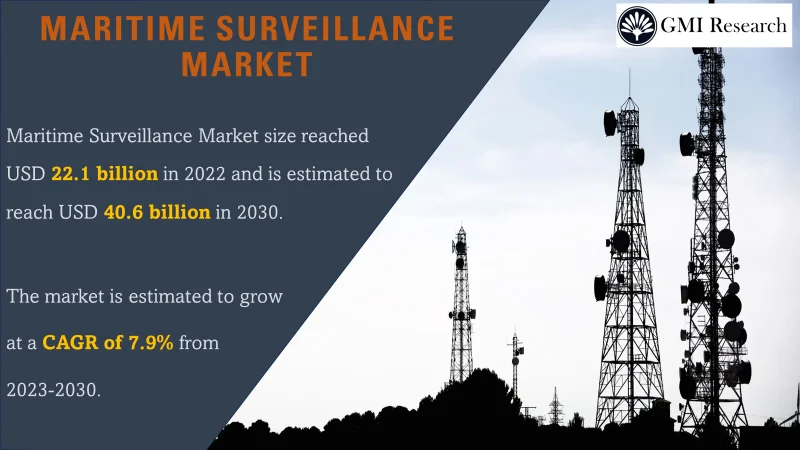Maritime Surveillance Market Size, Share, Trends and Growth Report – Global Opportunities & Forecast, 2023-2030
Analysis from GMI Research finds that the Maritime Surveillance Market earned revenues of USD 22.1 billion in 2022 and estimated to touch USD 40.6 billion in 2030 will grow at a CAGR of 7.9% from 2023-2030.
Major Maritime Surveillance Market Drivers
The maritime surveillance market is predicted to witness considerable growth due to a significant rise in demand for maritime security and safety around the globe and the rapid rise in several terrorist threats and piracy incidents. The growing number of collaborations, and partnerships, a considerable rise in security problems during seafaring, growing demand for managing complex supply chain functions, escalating freight and trade transport activities around the sea, and piracy contribute to the present maritime landscape. The growing focus on developing marine safety and security fuels the need for maritime surveillance solutions. An increase in global ocean trade leads to a rise in maritime traffic. As the oldest and most extensively employed cargo export and import method, maritime trade proves advantageous for transporting heavyweight items. The heightened transit through seaways has advanced the presence of trading vessels at sea, consequently raising the incidence of maritime crime globally. In response, measures for surveillance have been implemented to counter activities such as illegal immigration, piracy, smuggling, and several other oceanic criminal acts. The rising international pressure and terrorism have reinforced the preference for maritime surveillance to develop the maritime well-being and security of the country. These are the foremost drivers predicted to propel the growth of the global maritime surveillance market.
Moreover, the market is witnessing growth driven by the rising generation of maritime surveillance solutions and the abundance of products offering such surveillance. For instance, in 2022, Norway unveiled plans for a satellite constellation in partnership with the European Space Agency to carry continuous real-time maritime surveillance. Furthermore, market growth is further driven by increasing awareness of safety and sustainability around the marine industry. Improved technologies such as RFID, GPS, Blockchain, and Robotics, are predicted to decrease terrorism, and piracy incidents in seas and oceans. Maritime borders integrate territorial and national security during trade, migration, and immigration. The importance of patrolling territorial water locations with state-of-the-art flying platforms is on the increase, specifically in countries with extensive coastlines. Maritime surveillance operations serve the determination of recognizing and detecting threats, as well as conducting security strategies.
Sample Request
To have an edge over the competition by knowing the market dynamics and current trends of “Maritime Surveillance Market” request for Sample Report here
Transformation-based structures, including thermal imaging, automatic identification systems, underwater robotic systems, and tracing devices, are employed to develop the scope and reliability of sea reconnaissance and security activities. Sales in the maritime surveillance market are growing, propelled by the remarkable design of these aircraft specifically personalized for monitoring sea activities. Moreover, the growing foreign pressure and heightened terrorist measures have reinforced the adoption of MSI to develop the maritime well-being and security of the country. These key drivers are estimated to drive the global maritime surveillance market size.
The growing adoption of robotic technology to bolster maritime surveillance capabilities emerges as a significant trend. Improved robotics, used in different industries to develop and enhance safety and security measures. A set of devices, online services, software, and robots have emerged as key factors propelling economic and social development. In the maritime industry, robots serve different determinations, varying from maintenance and cleaning tasks to the function of fully autonomous vessels without a crew of captains on board. For instance, SEA-KITs Maxlimer represents a fully robotic ship capable of autonomous travel, accompanied by a fleet of submarines, small drones, and boats.
Request Research Methodology
Do you want to know more about the Research process and detailed Methodology, Request Research Methodology of this report
However, implementing and sustaining marine surveillance systems may demand substantial investments in infrastructure, equipment, and personnel. The notably high costs linked with acquiring and sustaining these systems can be predicted to significant barrier, especially for nations with restricted resources. For effective maritime surveillance, systems must integrate different technologies, maintain platforms neutrally, and possess effective data-sharing and analytic capabilities. The implementation and efficacy of such systems may face different challenges, including the resolution of technical issues and the assurance of seamless integration.
Whereas, global maritime traffic is predicted to increase due to international sea trade. The growth of seaway transportation has led to an increased presence of diverse trader ships at sea, consequently contributing to a rise in marine criminal activities in the current period. In response to these hurdles, nations worldwide are proactively enhancing and developing their maritime surveillance solutions to offset the criminal activities. This positive approach is estimated to boost a long-term growth in the maritime surveillance industry.
Request for Customization
In case, any of your pain points areas are not covered in the current scope of this report, Request for Customization here
By Type, Surveillance and Tracking Segment is predicted to observe growth in the forecast duration
Present trends in the maritime surveillance and intervention market involve an increasing usage of radars, remotely functioned vehicles (ROV), and sensor systems for effective undersea surveillance management. An ROV is an automated underwater robot tethered to the ship through linked cables. These cables convey instructions and control signals between the operative and the remotely functioned vehicles, allowing the automobile to be remotely navigated. Thus, the steady growth of this segment is attributed to different tracking software to analyze and assess the place and provide necessary alerts to prevent ports, vessels, and several other shipping infrastructures. In addition, the increasing prevalence of maritime threats, such as piracy, has prompted nations globally to develop their technologies connected to maritime surveillance and navigating abilities. Surveillance in maritime surroundings is important in countering a broad range of criminal practices, encompassing unauthorized fishing, and pirate attacks. Moreover, technologies like computer vision can provide valuable support in law enforcement procedures, specifically in tracking and recognizing transporting vessels on the ocean. Distinguishing between artificial structures at sea and marine life, and tracking different targets despite different obstructions, is important for robust maritime systems. These factors markedly influence the choice of surveillance methodology.

Furthermore, there is an increasing need for maritime security in ports and coastal areas, specifically around regions such as the Carribbean, Russia, and LATAM, where incidents of piracy attacks and robberies have risen speedily in recent years is estimated to propel significant demand for these devices and further present a boost in surveillance and tracking segment in global market of maritime surveillance.
By Region, Asia Pacific is Predicted to Observe Fastest Growth in Maritime Surveillance Market
The Asia Pacific region is expected to experience significant growth, driven by the increasing need to detect maritime hazards and enable effective communication with officials in the maritime sector through the usage of advanced software. In recent years, China had not actively engaged in maritime security. However, there was a shift in 2021 when China employed civilian vessels for maritime surveillance operations. Furthermore, with the initiation of the ‘Spratly Backbone Fleet’ program, the Chinese government is expending the fleet committed to maritime surveillance practices. This initiation deploys nearly 300 to 400 vessels at any period. However, within the Spratly fleet, China oversees nearly 800 to 1,000 commercial fishing boats and maintains nearly 200 more vessels as part of the professional maritime militia. Also, China has been escalating its submarine deterrent patrols to ensure thorough mapping of underwater terrain and to carry out effective surveillance practices. Nonetheless, Japan is actively investing in strengthening its maritime potential. Plans include the acquisition and realignment of intelligence, surveillance tracking, and reconnaissance assets in sensitive locations. Upgrades to naval patrol craft, missile units, ground force radars and the advancement of amphibious offensive capability within a joint JSDF task force are also part of the agenda. These strategic advancements are anticipated to play a growing role in contributing to the growth of the maritime surveillance market in APAC in the forecast period.

Top Market Players
Various notable players operating in the market include Kongsberg Gruppen, SRT Marine Systems Plc, Raytheon Anschutz GmbH, Bharat Electronics, Thales Group, SAAB, Elbit Systems, Indra Systems, Terma, Furuno Electric Co Ltd among others.
Sample Request
For detailed scope of the “Maritime Surveillance Market” report request a Sample Copy of the report
Key Developments
-
- In 2022, SRT Marine Systems signed an agreement with a significant coastguard to carry an unnamed national coastguard across southeast Asia along an original ‘SRT-MDA’ maritime monitoring system.
- In 2022, Ocean Power Technologies chosen by Amentum Services for a procurement valued at USD 529,025. This selection is intended to actively support Amentum in delivering information analysis services to the U.S. Department of Homeland Security Science & technology Directorate, encompassing space, land, air, and port & coasting surveillance.
- In 2022, Unseenlabs announced the launch of BRO-8, the latest satellite to deliver clients with data and analytics reliant on the interference of RF Signals regardless of weather conditions and time boundaries.
Segments covered in the Report:
The Global Maritime Surveillance Market has been segmented on the basis of Application, Component and Type. Based on the Application, the market is segmented into Coastguard, Naval and Other Applications. Based on the Component, the market is segmented into Radar, Sensor, Transponder, Other Components. Based on the Type, the market is segmented into Surveillance and tracking, Detectors, Other Types.
|
Report Coverage |
Details |
| Market Revenues (2022) |
USD 22.1 Billion |
| Market Base Year |
2022 |
| Market Forecast Period |
2023-2030 |
| Base Year & Forecast Units |
Revenues (USD Billion) |
| Market Segment | By Application, By Component, By Type, By Region |
| Regional Coverage | Asia Pacific, Europe, North America, and RoW |
| Companies Profiled | SRT Marine Systems Plc, Kongsberg Gruppen, Bharat Electronics, Raytheon Anschutz GmbH, Thales Group, SAAB, Elbit Systems, Indra Systems, Terma, Furuno Electric Co Ltd, among others; a total of 10 companies covered. |
| 25% Free Customization Available | We will customize this report up to 25% as a free customization to address our client’s specific requirements |
Market Segmentation
Global Maritime Surveillance Market by Application
-
- Naval
- Coastguard
- Other Applications
Global Maritime Surveillance Market by Component
-
- Radar
- Sensor
- Transponder
- Other Components
Global Maritime Surveillance Market by Type
-
- Surveillance and tracking
- Detectors
- Other Types
Global Maritime Surveillance Market by Region
-
-
North America Maritime Surveillance Market (Option 1: As a part of the free 25% customization)
- By Application
- By Component
- By Type
- US Market All-Up
- Canada Market All-Up
-
Europe Maritime Surveillance Market (Option 2: As a part of the free 25% customization)
- By Application
- By Component
- By Type
- UK Market All-Up
- Germany Market All-Up
- France Market All-Up
- Spain Market All-Up
- Rest of Europe Market All-Up
-
Asia-Pacific Maritime Surveillance Market (Option 3: As a part of the free 25% customization)
- By Application
- By Component
- By Type
- China Market All-Up
- India Market All-Up
- Japan Market All-Up
- Rest of APAC Market All-Up
-
RoW Maritime Surveillance Market (Option 4: As a part of the free 25% customization)
- By Application
- By Component
- By Type
- Brazil Market All-Up
- South Africa Market All-Up
- Saudi Arabia Market All-Up
- UAE Market All-Up
- Rest of world (remaining countries of the LAMEA region) Market All-Up
-
Global Maritime Surveillance Leading Market Players (Option 5: As a part of the free 25% Customization – Profiles of 5 Additional Companies of your Choice)
-
- SRT Marine Systems Plc
- Kongsberg Gruppen
- Bharat Electronics
- Raytheon Anschutz GmbH
- Thales Group
- SAAB
- Elbit Systems
- Indra Systems
- Terma
- Furuno Electric Co Ltd
Related Reports
- Published Date: Nov-2023
- Report Format: Excel/PPT
- Report Code: UP3574-001001
Licensing Options
Single-User License:
The report is used by the purchaser (One Individual) only
Multi-User License:Report is shared with maximum 5 users (employees) including the purchaser of the purchasing corporation only
Corporate License:
Report is shared with unlimited user (employees) of the purchasing corporation only
The report is used by the purchaser (One Individual) only
Multi-User License:Report is shared with maximum 5 users (employees) including the purchaser of the purchasing corporation only
Corporate License:
Report is shared with unlimited user (employees) of the purchasing corporation only
Maritime Surveillance Market Size, Share, Trends and Growth Report – Global Opportunities & Forecast, 2023-2030
$ 4,499.00 – $ 6,649.00
Why GMI Research








